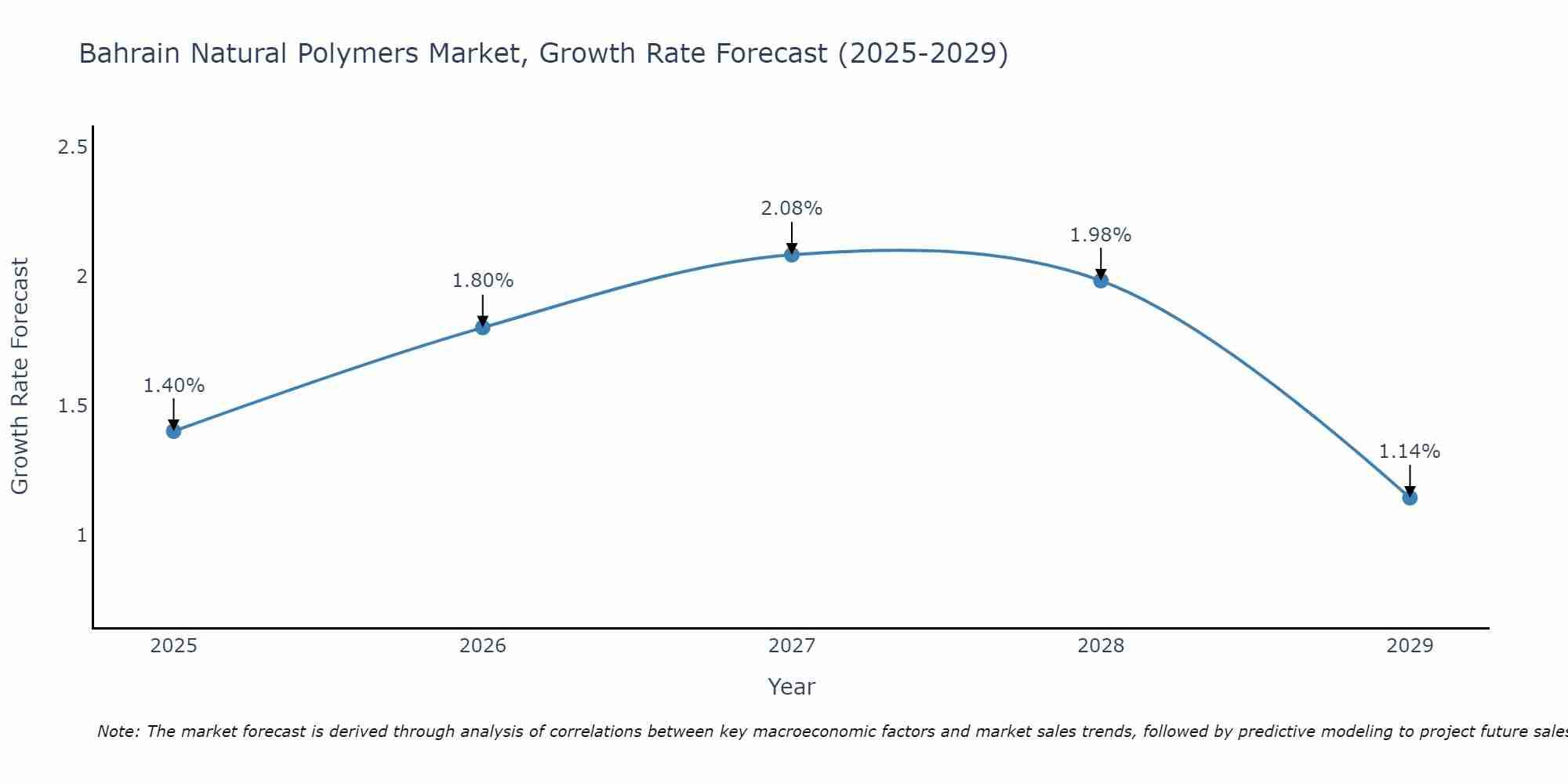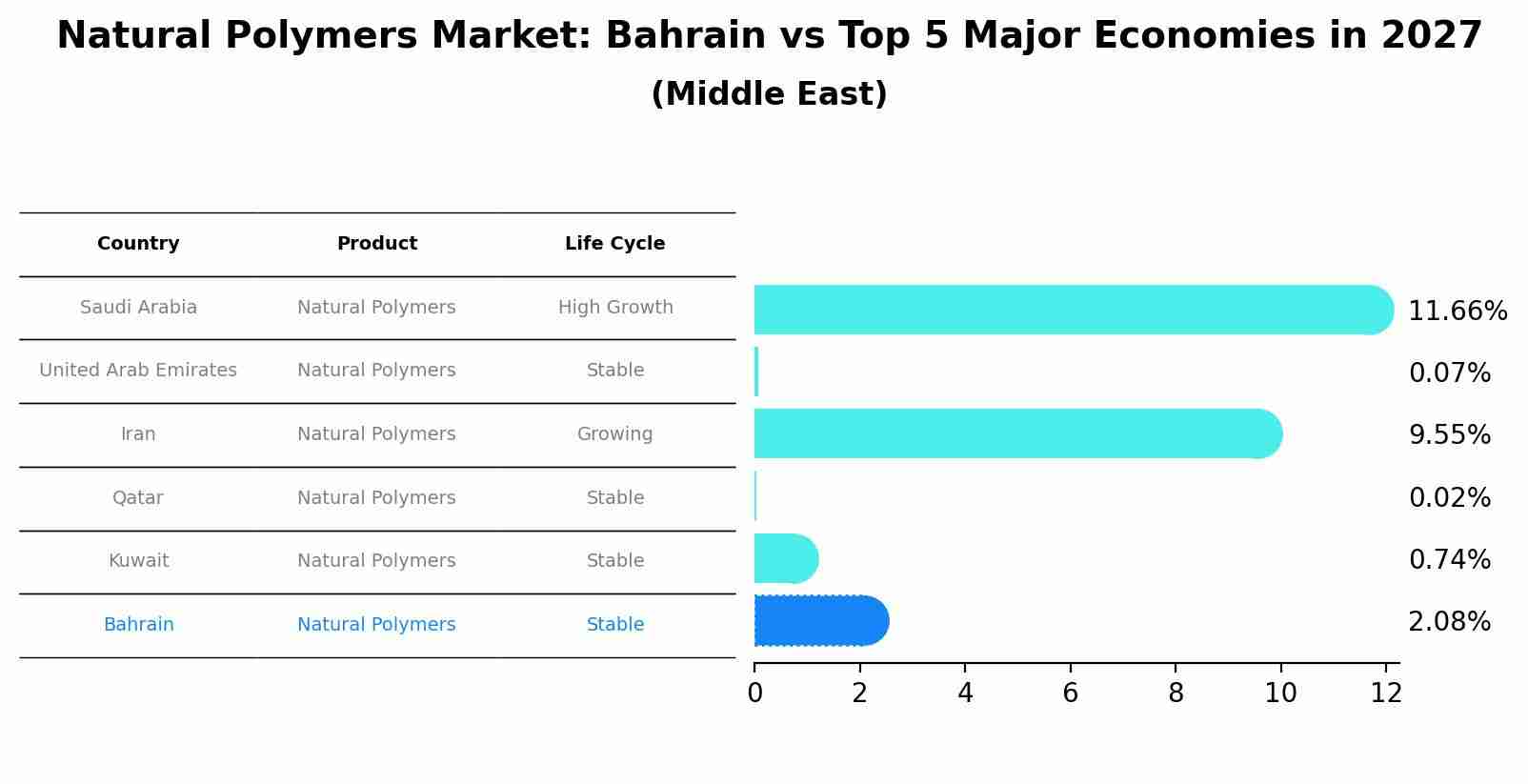Bahrain Natural Polymers Market Outlook | Analysis, Trends, Size, Revenue, Industry, Share, COVID-19 IMPACT, Growth, Forecast, Value & Companies
| Product Code: ETC334544 | Publication Date: Aug 2022 | Updated Date: Aug 2025 | Product Type: Market Research Report | |
| Publisher: 6Wresearch | Author: Shubham Padhi | No. of Pages: 75 | No. of Figures: 35 | No. of Tables: 20 |
Bahrain Natural Polymers Market Size Growth Rate
The Bahrain Natural Polymers Market is projected to witness mixed growth rate patterns during 2025 to 2029. Growth accelerates to 2.08% in 2027, following an initial rate of 1.40%, before easing to 1.14% at the end of the period.

Natural Polymers Market: Bahrain vs Top 5 Major Economies in 2027 (Middle East)
By 2027, the Natural Polymers market in Bahrain is anticipated to reach a growth rate of 2.08%, as part of an increasingly competitive Middle East region, where Saudi Arabia remains at the forefront, supported by United Arab Emirates, Iran, Qatar and Kuwait, driving innovations and market adoption across sectors.

Bahrain Natural Polymers Market Synopsis
Natural polymers such as starch, cellulose, and chitosan are gaining traction in Bahrain for use in bioplastics, food packaging, and pharmaceuticals. As sustainability becomes more prominent, these biodegradable materials are favored in environmentally conscious applications. Government initiatives and international trade exposure further drive the market toward greener alternatives.
Trends of the market
The natural polymers market in Bahrain is expanding, driven by rising interest in eco-friendly alternatives to synthetic plastics. Applications include food packaging, biomedicine, and personal care products. Starch, cellulose, and alginate-based polymers are becoming more prominent. Innovation is focused on improving mechanical strength and biodegradability to support sustainability goals.
Challenges of the market
The market for natural polymers in Bahrain is hindered by limited industrial applications and a lack of domestic manufacturing capabilities. These materials often command higher prices than synthetic alternatives, making cost a major limiting factor in their adoption. Import dependence and regulatory approvals for food-grade or pharmaceutical applications further slow down market expansion. Low consumer awareness about the environmental benefits of natural polymers also restricts their usage in packaging or product formulations.
Investment opportunities in the Market
Natural polymers, used in packaging, medical devices, and food applications, are becoming more sought after as sustainability concerns grow. Bahrains manufacturing and packaging sectors present opportunities for investing in natural polymer production, particularly in biodegradable packaging materials. Investors can explore creating new applications or enhancing the performance of natural polymers, particularly those that can replace traditional plastics.
Government Policy of the market
Natural polymers, such as cellulose, chitosan, and starch derivatives, are gaining popularity in Bahrain due to environmental and health considerations. The government supports the shift toward biodegradable materials by offering policy incentives for companies using natural polymers in packaging, agriculture, and healthcare. Regulatory oversight ensures that these polymers meet performance benchmarks and are safe for intended applications. Bahrain is also exploring regional collaborations to source raw materials sustainably and reduce reliance on synthetic alternatives, aligning with its long-term green development goals.
Key Highlights of the Report:
- Bahrain Natural Polymers Market Outlook
- Market Size of Bahrain Natural Polymers Market, 2021
- Forecast of Bahrain Natural Polymers Market, 2031
- Historical Data and Forecast of Bahrain Natural Polymers Revenues & Volume for the Period 2018 - 2031
- Bahrain Natural Polymers Market Trend Evolution
- Bahrain Natural Polymers Market Drivers and Challenges
- Bahrain Natural Polymers Price Trends
- Bahrain Natural Polymers Porter's Five Forces
- Bahrain Natural Polymers Industry Life Cycle
- Historical Data and Forecast of Bahrain Natural Polymers Market Revenues & Volume By Product Type for the Period 2018 - 2031
- Historical Data and Forecast of Bahrain Natural Polymers Market Revenues & Volume By Cellulose Ethers for the Period 2018 - 2031
- Historical Data and Forecast of Bahrain Natural Polymers Market Revenues & Volume By Exudate And Vegetable Gums for the Period 2018 - 2031
- Historical Data and Forecast of Bahrain Natural Polymers Market Revenues & Volume By Starch And Fermentation Products for the Period 2018 - 2031
- Historical Data and Forecast of Bahrain Natural Polymers Market Revenues & Volume By Other Polymers for the Period 2018 - 2031
- Historical Data and Forecast of Bahrain Natural Polymers Market Revenues & Volume By Industry for the Period 2018 - 2031
- Historical Data and Forecast of Bahrain Natural Polymers Market Revenues & Volume By Packaging Material for the Period 2018 - 2031
- Historical Data and Forecast of Bahrain Natural Polymers Market Revenues & Volume By Medical & Cosmetics for the Period 2018 - 2031
- Historical Data and Forecast of Bahrain Natural Polymers Market Revenues & Volume By Inks & Paints for the Period 2018 - 2031
- Historical Data and Forecast of Bahrain Natural Polymers Market Revenues & Volume By Adhesives for the Period 2018 - 2031
- Bahrain Natural Polymers Import Export Trade Statistics
- Market Opportunity Assessment By Product Type
- Market Opportunity Assessment By Industry
- Bahrain Natural Polymers Top Companies Market Share
- Bahrain Natural Polymers Competitive Benchmarking By Technical and Operational Parameters
- Bahrain Natural Polymers Company Profiles
- Bahrain Natural Polymers Key Strategic Recommendations
Frequently Asked Questions About the Market Study (FAQs):
1 Executive Summary |
2 Introduction |
2.1 Key Highlights of the Report |
2.2 Report Description |
2.3 Market Scope & Segmentation |
2.4 Research Methodology |
2.5 Assumptions |
3 Bahrain Natural Polymers Market Overview |
3.1 Bahrain Country Macro Economic Indicators |
3.2 Bahrain Natural Polymers Market Revenues & Volume, 2021 & 2031F |
3.3 Bahrain Natural Polymers Market - Industry Life Cycle |
3.4 Bahrain Natural Polymers Market - Porter's Five Forces |
3.5 Bahrain Natural Polymers Market Revenues & Volume Share, By Product Type, 2021 & 2031F |
3.6 Bahrain Natural Polymers Market Revenues & Volume Share, By Industry, 2021 & 2031F |
4 Bahrain Natural Polymers Market Dynamics |
4.1 Impact Analysis |
4.2 Market Drivers |
4.2.1 Increasing demand for eco-friendly and sustainable products |
4.2.2 Growth in end-use industries such as packaging, construction, and automotive |
4.2.3 Government initiatives promoting the use of natural polymers in various applications |
4.3 Market Restraints |
4.3.1 Limited availability of raw materials for natural polymers production |
4.3.2 High cost of production compared to synthetic polymers |
4.3.3 Lack of awareness and understanding about the benefits of natural polymers among consumers |
5 Bahrain Natural Polymers Market Trends |
6 Bahrain Natural Polymers Market, By Types |
6.1 Bahrain Natural Polymers Market, By Product Type |
6.1.1 Overview and Analysis |
6.1.2 Bahrain Natural Polymers Market Revenues & Volume, By Product Type, 2021-2031F |
6.1.3 Bahrain Natural Polymers Market Revenues & Volume, By Cellulose Ethers, 2021-2031F |
6.1.4 Bahrain Natural Polymers Market Revenues & Volume, By Exudate And Vegetable Gums, 2021-2031F |
6.1.5 Bahrain Natural Polymers Market Revenues & Volume, By Starch And Fermentation Products, 2021-2031F |
6.1.6 Bahrain Natural Polymers Market Revenues & Volume, By Other Polymers, 2021-2031F |
6.2 Bahrain Natural Polymers Market, By Industry |
6.2.1 Overview and Analysis |
6.2.2 Bahrain Natural Polymers Market Revenues & Volume, By Packaging Material, 2021-2031F |
6.2.3 Bahrain Natural Polymers Market Revenues & Volume, By Medical & Cosmetics, 2021-2031F |
6.2.4 Bahrain Natural Polymers Market Revenues & Volume, By Inks & Paints, 2021-2031F |
6.2.5 Bahrain Natural Polymers Market Revenues & Volume, By Adhesives, 2021-2031F |
7 Bahrain Natural Polymers Market Import-Export Trade Statistics |
7.1 Bahrain Natural Polymers Market Export to Major Countries |
7.2 Bahrain Natural Polymers Market Imports from Major Countries |
8 Bahrain Natural Polymers Market Key Performance Indicators |
8.1 Percentage increase in research and development investments in natural polymers |
8.2 Number of new product launches using natural polymers |
8.3 Adoption rate of natural polymers in key industries in Bahrain |
9 Bahrain Natural Polymers Market - Opportunity Assessment |
9.1 Bahrain Natural Polymers Market Opportunity Assessment, By Product Type, 2021 & 2031F |
9.2 Bahrain Natural Polymers Market Opportunity Assessment, By Industry, 2021 & 2031F |
10 Bahrain Natural Polymers Market - Competitive Landscape |
10.1 Bahrain Natural Polymers Market Revenue Share, By Companies, 2021 |
10.2 Bahrain Natural Polymers Market Competitive Benchmarking, By Operating and Technical Parameters |
11 Company Profiles |
12 Recommendations |
13 Disclaimer |
- Single User License$ 1,995
- Department License$ 2,400
- Site License$ 3,120
- Global License$ 3,795
Search
Related Reports
- UAE Building Thermal Insulation Market Outlook (2025-2031) | Revenue, Companies, Share, Trends, Growth, Size, Forecast, Industry, Analysis & Value
- Portugal Electronic Document Management Market (2025-2031) | Strategy, Consumer Insights, Analysis, Investment Trends, Opportunities, Growth, Size, Share, Industry, Revenue, Segments, Value, Segmentation, Supply, Forecast, Restraints, Outlook, Competition, Drivers, Trends, Demand, Pricing Analysis, Competitive, Strategic Insights, Companies, Challenges
- France Electronic Document Management Market (2025-2031) | Strategy, Consumer Insights, Analysis, Investment Trends, Opportunities, Growth, Size, Share, Industry, Revenue, Segments, Value, Segmentation, Supply, Forecast, Restraints, Outlook, Competition, Drivers, Trends, Demand, Pricing Analysis, Competitive, Strategic Insights, Companies, Challenges
- Portugal Occupational Health & Safety Services Market (2025-2031) | Strategy, Consumer Insights, Analysis, Investment Trends, Opportunities, Growth, Size, Share, Industry, Revenue, Segments, Value, Segmentation, Supply, Forecast, Restraints, Outlook, Competition, Drivers, Trends, Demand, Pricing Analysis, Competitive, Strategic Insights, Companies, Challenges
- Netherlands Occupational Health and Safety Services Market (2025-2031) | Strategy, Consumer Insights, Analysis, Investment Trends, Opportunities, Growth, Size, Share, Industry, Revenue, Segments, Value, Segmentation, Supply, Forecast, Restraints, Outlook, Competition, Drivers, Trends, Demand, Pricing Analysis, Competitive, Strategic Insights, Companies, Challenges
- Belgium and Luxembourg Facility Management Market (2025-2031) | Strategy, Consumer Insights, Analysis, Investment Trends, Opportunities, Growth, Size, Share, Industry, Revenue, Segments, Value, Segmentation, Supply, Forecast, Restraints, Outlook, Competition, Drivers, Trends, Demand, Pricing Analysis, Competitive, Strategic Insights, Companies, Challenges
- Russia Women Intimate Apparel Market (2025-2031) | Strategy, Consumer Insights, Analysis, Investment Trends, Opportunities, Growth, Size, Share, Industry, Revenue, Segments, Value, Segmentation, Supply, Forecast, Restraints, Outlook, Competition, Drivers, Trends, Demand, Pricing Analysis, Competitive, Strategic Insights, Companies, Challenges
- Africa Chocolate Market (2025-2031) | Size, Share, Trends, Growth, Revenue, Analysis, Forecast, industry & Outlook
- Global Hydroxychloroquine And Chloroquine Market (2025-2031) | Industry, Trends, Size, Outlook, Growth, Value, Companies, Revenue, Analysis, Share, Forecast
- Saudi Arabia Plant Maintenance Market (2025-2031) | Industry, Size, Growth, Revenue, Value, Companies, Forecast, Analysis, Share & Trends
Industry Events and Analyst Meet
Our Clients
Whitepaper
- Middle East & Africa Commercial Security Market Click here to view more.
- Middle East & Africa Fire Safety Systems & Equipment Market Click here to view more.
- GCC Drone Market Click here to view more.
- Middle East Lighting Fixture Market Click here to view more.
- GCC Physical & Perimeter Security Market Click here to view more.
6WResearch In News
- Doha a strategic location for EV manufacturing hub: IPA Qatar
- Demand for luxury TVs surging in the GCC, says Samsung
- Empowering Growth: The Thriving Journey of Bangladesh’s Cable Industry
- Demand for luxury TVs surging in the GCC, says Samsung
- Video call with a traditional healer? Once unthinkable, it’s now common in South Africa
- Intelligent Buildings To Smooth GCC’s Path To Net Zero













